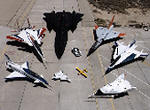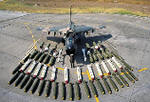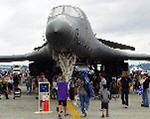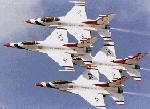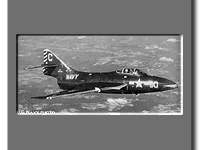
|
Description
| Manufacturer: | Grumman |
| |
| Base model: | F9F | ||
| Designation: | F9F | ||
| Version: | -7 | ||
| Nickname: | Cougar | ||
| Designation System: | U.S. Navy / Marines | ||
| Designation Period: | 1922-1962 | ||
| Basic role: | Fighter | ||
| See Also: |
Specifications
| Not Yet Available |
Recent comments by our visitors
| Duke Rohe Houston, TX | My dad was pilot #4 (Gordon S. Rohe) in the \'And then there were none...\'piece. Thanks for posting it. I have a Dallas Morning News article on it I have in pdf form. I had seen your article in a Navy periodical in our attic back in 1962. 07/02/2012 @ 19:17 [ref: 63029] |
| Charles Schwab Lovettsville, VA | Gentlemen,
Again, the Naval Aviation Safety Center has obtained a factual account of a flight situation of such impact as to warrant special treatment. And again, as in the presentation of the "Man With the Banjo" (Aviation Safety Bulletin No. 20-54) the report is offered without editorial comment and with only a brief introduction. --and then there were none-- It was a "routine" flight by members of a reserve squadron - eight pilots were scheduled; seven got airborne; five continued the flight to its unscheduled conclusion; one pilot died. Concerning the five pilots, it is believed that their individual experience and backgrounds provide a fairly typical cross-section of reserve aviation. The list, which might well be repeated in any of a hundred similar activities, includes a manager of an electrical supply firm, the director of industrial relations for an oil refinery, a member of a construction company, an associat e of a farmers' cooperative supply organization, and the director of a local chamber of commerce. Married, family men almost without exception, these pilots drive or are flown to their base once each month to engage in three or four flights and to log an average of about 10 flight hours per month. This is their story. EIGHT reserve pilots were scheduled for a VFR cross-country navigation flight to provide cruise control training in F9F-7s prior to engaging in forthcoming maneuvers. Originally projected several months before, the flight received final approval and pilots were designated about 1030 one Saturday morning. Because of the relatively short notice on which the flight was finally undertaken, the squadron found it necessary to obtain two replacement pilots from a local companion squadron. One of the replacements was designated flight leader because he had the necessary instrument qualification requ ired for such flights. Of the eight pilots scheduled, three had flown a hop the previously during the day; only four had made cross-country flights in the F9F- 7. As finally organized, the flight appeared something like this: Number 1: (flight leader) received checkout in F9F-7 two months before and had logged 10.7 hours in model. Number 2: Checked out in model a year previously and had about 60 hours in model. Number 3: Checked out in model previous year and had about 30 hours in model. Number 4: Checked out in model a year before; had about 29 hours in model. Number 5: Checked out about two months before and had approximately 20 hours in model. Number 6: Checked out a year before; had 20 hours in model. Number 7: Checked out about three months before; had about five hours in model. Number 8: Checked out a year before; had some 40 hours in model. Distance of the flight was 555 miles over a route whic h approached mountainous terrain near the destination. Weather briefing noted a tornado well to the southwest of the route and scattered thunderstorms predicted en route. Time en route was one hour 30 minutes, with the flight to arrive over destination with an estimated 1840 pounds of fuel remaining. Preflight planning was accomplished with most of the pilots working out their own flight plans, and with the flight leader completing a briefing "as thorough as any flight I ever briefed." Starting, departure from the line and preliminary radio check was according to normal procedure. One aircraft was delayed on starting and was left at the line. Radio communications check proved ifficult, with considerable shifting of frequency required to establish a common tactical channel. On reaching the head of the runway there was an initial delay of several minutes while a number of aircraft landed. Takeoff was at 1705. Joinup after takeoff was quickly accomplished and the leader then circled the field at a low altitude to check the status of the delayed aircraft, which failed to leave the line. Flight members figured that some 800 pounds of fuel had been expended during delays. Then There Were Seven Departure and climb to 36,000 feet on a northwest course was uneventful, but approximately 110 miles out on course the No.5 and No.6 men returned to base after reporting excessive fuel onsumption. No.7 then moved up into the No.5 position astern. Then There Were Five About 200 miles on course the flight encountered the first thunderstorm, an anvil head at about 32,000-34,000 feet, which they were able to drop under without difficulty. Thereafter several small thunderheads were flown over. Weather to the north and east of course appeared relatively clear. About 250 miles out the canopy of No.5, formerly No.7 began icing over despite constant use of manual control, and in a short time he was looking out "through a dollar-sized hole." In a few minutes, however, the icing abruptly disappeared. A radio check netted the report that destination weather was a comfortable 15,000 feet, scattered, with thunderstorms to the southeast. Noting what appeared to be a sizable thunderstorm ahead, the flight began climbing to top it. At this time No.5 began to lag behind. When the flight had attained 38,000-40,000 feet, and was nearing the thunderstorm, the flight leader advised he was reducing power to 87 percent to allow No.5 to catch up. No.5 gave a count for a DF steer from the planes ahead, which he could no longer see. On reduction of power by the leader, Nos. 3 and 4 overran and used their excess speed to pull up slightly higher than the rest the flight. Now No.3 called in that he as encountering stall in his airplane and No.5 noted the same c ondition. At this time pilot, possibly No.3, suggested reversal of course, but No.4, higher than the others, reported he could see over the top of the thunderstorm. Just short of the thunderstorm the leader began a left turn which immediately aggravated the stall of the aircraft. Mushing considerably, the flight entered the cloud, No.2 entering first, followed No.1, No.4 held course and altitude. No. 3's actions from this point are not known, but possibly he elected to go down through the clouds. No.5 attempted a 180 but stalled through the tops of the thunderstorms at about 39,000 feet. >From this point the integrity of the flight disappeared as each of the remaining pilots found himself in a situation requiring a separate solution. The account of how each pilot attempted to solve his individual problem follows. Lose Leader Completing his turn away from the cloud and circling in the clear at about 34,00 0-36,000, No.1 began calling the flight, but was unable to establish satisfactory communications. He then began a decent in the trough paralleling the near side of the cloud, throttle at idle, and leveled at 17,000 feet to go around the edge of the thunderhead and to resume base course. It was then apparent that le 1500 pounds of fuel remaining would be insufficient to make destination, and No.1 began looking for a place to land. Following a highway he descended to 5000 feet to select a stretch on which to set down. After dragging the road for obstructions he made an approach over a pickup truck and touched down, blowing a tire as brakes were applied. On landing runout he noted a slight hill over which he might expect to see a car come at any time, so he turned off the highway at a side road intersection to clear. A car immediately came over the hill to investigate the low flying airplane. Driven into a nearby town the pilot obtained the services of a tractor and a hired hand to tow the plane into town. This was accomplished after a few mishaps involved in being towed off the pavement onto the soft shoulder. Thereafter No.1 was advised of the crash of another aircraft some 40 miles away and was driven to the scene to assist in its identification. Then There Were Four On entering the cloud, No.2 elected to descend through what he assumed to be only a layer, to bust out under, and remain contact to go on to destination. He extended speed brakes, reduced throttle and began a 5000-6000 fpm rate of descent, holding base course. The descent was considerably prolonged. He first encountered lightning and then severe turbulence, and meanwhile he attempted to hold a nose-down attitude to prevent stalling. After the first period of turbulence No.2 became concerned about his altitude with reference to surrounding terrain, b elieving that below 15,000 feet he would be dangerously near to the mountains ahead. He turned north, and got into more violent turbulence, lost control of the airplane a couple of times and at 15,000 feet decided to eject. Still in turbulence, still in a dive, he jettisoned his canopy (he lost his helmet but does not recall when this occurred), and releasing the controls, pulled the curtain. Nothing happened, but he had been told that he might reasonably expect a two or three-second delay in the firing of the seat, so he was not particularly upset over the delay. Curtain over his chin, he waited-then decided to peek around the curtain to see if he were still in the airplane. He was. He released the curtain, waited, still diving, considered re-safetying the curtain, discarded the idea and went back to driving the airplane While considering his next move he saw the ground materializing below to show that he still had a safe altitude. Breaking out beneath the clouds at about 5500 feet he retracted speed brakes and took up an easterly heading, unable to get much speed because of the absence of the canopy. After searching for a time for a place to land, he selected a stretch of highway, near a town. He was down to 500 pounds of fuel now. Checking the wind from the local trash dump he made an approach over an automobile at about 150 feet, leveled at 10 feet, cut the throttle and landed. Slowing to taxi, he folded the wings to cross a bridge and continued into town where he turned off to park on a side street. After his report was made, arrangements were made for a nearby air station to send a crew with another canopy, fuel, a starter unit, and to disarm the hot seat. Faced with the problem of what to do with o the seat cartridge, the pilot considered throwing it into a lake, burying it, and then obtained a shotgun from a patrolman and shot the side of the shell open, rupturing it so the powder could be removed. The shell case was turned over to investigating personnel for further check When the airplane was ready for flight, it was pushed by local citizens back to the highway, which was blocked off. A clear stretch of road about a mile in length was then available before the highway crossed a low bridge. Thereafter, another mile of open highway was usable. There was no fuel in the wing tanks; elevation of the "field" - was 2200feet. The airplane was almost airborne at the first bridge, and in accordance with his pre-planning, the pilot was able to lift the plane up on the oleos to clear the bridge safely. Thereafter he was airborne on the second stretch of runway. After I got off," said the pilot, "I came back and made a pass by the town to do a roll of appreciation for their help. Then There Were Three Because No.3 was not observe d from the time the flight entered the top of the cloud, nor were any radio transmissions heard, his actions may only be guessed. The airplane crashed some 40 miles away from the point at which No.1 landed. The plane hit in a near-vertical angle on the corner of a cement foundation of a farm structure, digging a large hole and being demolished by the impact. After the initial inspection the investigating party concluded that the ejection seat was not in the wreckage. Shortly thereafter, because of the inconvenience caused the property owner by the crowds of spectators and souvenir hunters attracted to the scene, it was decided to bulldoze the wreckage into the hole and to cover it up. The pilot was later found, dead of injuries which' possibly resulted from hitting some part of the plane on bailout. Questions then raised concerning the absence of the ejection seat prompted the re-opening of the crash hole to re-examine the wreckage. Parts of the ejection seat were then found in the wreckage. Then There Were Two The No.4 man stated that from his position 1000-2000 feet above the rest of the flight, he could see over the top of the cloud, and recommended going over. However, when the leader reduced power to allow No.5 to catch up, No.4 encountered, stall and began to lose altitude. He increased power to 100 percent but still lost some 1000 feet more. A tentative turn with the rest of the flight increased the stall and he returned to base course and was in the cloud. He too, thought he would be able to penetrate quickly. Within the cloud, he reports that his fuel consumption appeared to have increased, and he decided to get down in order to have some fuel remaining for landing. At this time he had about 1500 pounds. Knowing that a range of mountains was directly ahead on course he turned to parallel the mountains and continue d his descent at about 4000 fpm. He too encountered violent turbulence but the airplane handled very well and he ever lost control. He attempted to raise CAA and Navy towers without success and then called "Mayday." His only answer was from an Air Force B-25 which gave him some idea of weather conditions beyond the storm area. At 15,000 feet he heard No. 2 call he was in the clear. At 12,000 feet the fuel warning light came on (he had not retarded throttle during his descent). At 11,000 feet he broke out beneath the thunderstorm and turned to intercept base course. After attempting to locate himself by landmarks and down to 700 pounds of fuel remaining he circled a reservoir with the intention of a water ditching. Noting the length of the reservoir dam, about 9300 feet, and its width, some 25 feet, he elected to try and land on the dam itself. To one side, the water level was about 15 feet below the top of the dam. On the other side was a drop of about 250 feet. A guard rail, about three feet high ran along either edge of the dam. On touchdown, he avoided use of brakes and, flaps clattering on the tops of the guardrail pipes, completed the rollout and added power to taxi off the far end of the dam. Taxing down to some buildings he was met by an irate reclamation official who advised him that "Son, you're in trouble! You can't go landing on government property like this!" Shortly thereafter, arrangements were made to report the landing and for the removal of the airplane. Then There WAS One At the time the formation approached the cloud, No., 5 was at about 39,000 feet at about, 170 knots, stalling through the tops of the clouds. On trying to make a 180, he stalled and mushed into the clouds. Attempting to fly out of the clouds on instruments, he also hit violent turbulence, being flipped on his back and getting into other unusual attitudes. At times he was gaining 6000 fpm and at other times he was descending 4000 fpm. He came out below the clouds at 17,000 feet in a slight nosedown turn, but a low airspeed brought on a stall. He nosed over to pick up speed and lost altitude down to 6000 feet. He then climbed back to 15,000, having about 1900 pounds of fuel left. Taking up an easterly course away from the storm area he was unable to establish his position, and spotting an abandoned airstrip, with only 700 pounds of fuel indicated, he elected to land. The strip was about 5800 feet long, and landing was without incident. No.5 then "took a chance and started walking." He was later informed that he was quite fortunate in his choice of direction, for had he taken the opposite direction he would have found no houses, just a long stretch of open country. He found a house and was able to report his landing and arrange for fuel to be brought to the airstrip. Then, he reports, "I got my biggest shock when I saw a spectator smoking near the airplane as it was being fueled!" The plane was returned to base. - And Then There Were None. The Aviation Safety Center is indebted to the pilots who voluntarily provided this candid account for the benefit of other pilots. 06/30/2007 @ 15:54 [ref: 16994] |
Recent photos uploaded by our visitors

